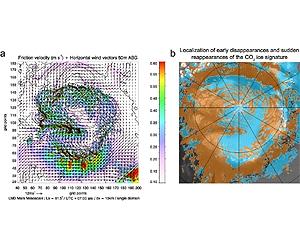 (a) Simulation of katabatic (downhill) winds. Color bar: friction velocity from 0.1 to 0.6 m/s. (b) Localization of regions where early disappearances (blue) and sudden reappearances (orange) of the carbon dioxide ice signature are observed. |
Scientists may have solved the mystery of the carbon dioxide ice disappearance early in the Northern Martian springs followed later by its sudden reappearance, revealing a very active water cycle on the planet. Dr. Bernard Schmitt and Mr. Thomas Appere are reporting their results at the European Planetary Science Congress in Rome this week through Friday 24th September.
Seasonal ice deposits are one of the most important Martian meteorological processes, playing a major role in the water cycle of the planet. Every Martian year, alternatively during northern and southern winter, a significant part of the atmosphere condenses on the surface in the form of frost and snow.
These seasonal ice deposits, which can be up to one meter thick, are mainly composed of carbon dioxide with minor amounts of water and dust. During spring, the deposits sublimate (vaporize), becoming a substantial source of water vapor, in particular in the northern hemisphere of the planet.
Dr. Schmitt and his colleagues Thomas Appere and Dr. Sylvain Doute at the Laboratoire de Planetologie de Grenoble, France, have analyzed data taken with the OMEGA instrument onboard Mars Express, for two northern Martian regions.
Before the Mars Express mission (ESA), the evolution of the seasonal deposits has been monitored by the albedo (reflectivity) and temperature changes of the surface, as the ice deposits appear much brighter and are colder than the surrounding defrosted terrains.
"But we couldn't resolve their exact composition and how they were distributed on the planet. Near-infrared observations, such as the OMEGA data, are much better for detecting strong signatures of water and carbon dioxide ice," says Mr. Appere.
The first Martian region that the scientists observed is located on Gemina Lingula, a Northern plateau, where peculiar evolution of the carbon dioxide ice deposits was observed.
"During spring the ice signature disappeared from our data, but the surface temperature was still cold enough to sustain plenty of CO2 ice. We concluded that a thick layer of something else, either dust or water ice, was overlaid. If it was dust then it would also hide water ice and the surface of the planet would become darker. None of these happened so we concluded that a layer of water ice was hiding the CO2 ice. We had to wait until the weather gets warm enough on Mars for the water to vaporize as well, and then the carbon dioxide signatures re-appeared in our data," explains Dr. Schmitt.
Soon after spring sunrise, the solar radiation hitting the surface of Mars warms enough the CO2 ice lying on the top layer to cause it to vaporize. But the water ice needs higher temperatures to sublimate, so a fine grained layer of water ice gradually forms hiding the carbon dioxide ice still lying beneath it.
"A layer only 2 tenths of a millimeter thick is enough to completely hide the CO2 ice. Also some water that has been vaporized at lower, warmer, Martian latitudes condenses as it moves northward and may be cold trapped on top of the CO2 ice," says Mr. Appere.
The second region analyzed by the team is located in the spiral troughs structure of the North permanent cap. A similar situation was observed but the carbon dioxide ice re-appeared very quickly here after its initial disappearance.
"This hide-and-seek game didn't make much sense to us. It wasn't cold enough for CO2 ice to condense again, neither warm enough for water ice to sublimate," explains Dr. Schmitt.
"We concluded that somehow the water ice layer was removed. The topography of the North permanent Martian cap is well-suited to entail the formation of strong katabatic (downhill) winds. Dr. Aymeric Spiga used a model from the Laboratoire de Meteorologie Dynamique du CNRS to simulate those winds and he indeed confirmed the sudden re-appearances of CO2 ice where strong katabatic winds blow," says Mr. Appere.
Dr. Schmitt concludes: "To decipher the present and past water cycles on Mars and improve our weather models on the planet, one needs to have a good understanding of the seasonal ice deposits dynamics, how they change in space and time. We are confident that our results will make a significant contribution in this direction".
marsdaily.com

No comments:
Post a Comment